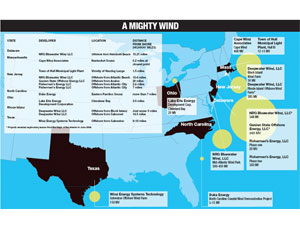The U.S. offshore wind market, which has lagged behind Europe for 20 years, has made significant strides in the past month as the controversial Cape Wind project near Cape Cod, Mass., received the first-ever approval from the U.S. Dept. of Interior to build such a wind farm. The project inked a power sales agreement with National Grid for half the output of the 468-MW wind farm.
Boston-based Cape Wind is years ahead of most other projects; its contract with London-based National Grid Plc says it must be online in 2013. However, other U.S. developers have a long way to go to catch up with their European counterparts before they can begin to construct offshore wind farms.
“The logistics, ports, harbors and vessels for this industry don’t exist on the Atlantic, and they can’t be imported from Europe,” says Walt Musial, a principal engineer with the National Renewable Energy Laboratory in Golden, Colo. “The U.S. is going to have to develop that infrastructure and that supply chain.”
Jim Lanard, managing director of Deepwater Wind LLC, based in Hoboken, N.J., which is developing two wind farms off Rhode Island, says his company is looking at oil and gas engineers and contractors in the Gulf of Mexico as well as European offshore firms—such as Copenhagen, Denmark-based Ramboll—to fill the need for construction and engineering expertise.
Knowledge is needed to do things such as design offshore wind towers—designs that aren’t always transferable from Europe to the United States. Some areas off the U.S. Atlantic Ocean coast are much deeper than areas in the North Sea or on the Atlantic’s U.K. side and may require a three- or four-legged jacket structure, similar to an offshore oil platform for stability, rather than the monopole tower that is common in shallower European waters. Very deep waters may require other measures, such as a floating turbine, now being developed by a consortium led by the University of Maine’s Advanced Structures and Composites Center. A $25-million Dept. of Energy grant is aiding that effort.
Powering Up
A growing number of companies are getting involved in the U.S. offshore wind market as U.S. policy on offshore wind farms has become clearer over the past 18 to 24 months, culminating in the Dept. of Interior decision on April 28 to allow the Cape Wind farm to proceed.
Irving, Texas-based Fluor Corp. is venturing into the U.S. market after working for years in the offshore wind market in the United Kingdom. The engineering and construction firm has had its eye on the U.S. market for quite a while, but the tax benefits, demand for offshore wind and regulatory structure only just recently have solidified.
“To be honest with you, we weren’t quite ready to jump in,” explains Richard Fierce, senior vice president of sales for Fluor’s industrial and infrastructure group. The company now is engaged fully with U.S. offshore wind developers, offering its expertise in financing public-private partnerships as well as its general knowledge of offshore construction.
For example, Fluor is managing construction of the meteorological tower for NRG Energy’s BlueWater Wind project off Delaware. That project, being developed by West Windsor, New Jersey-based NRG Energy Inc., would add...


Post a comment to this article
Report Abusive Comment